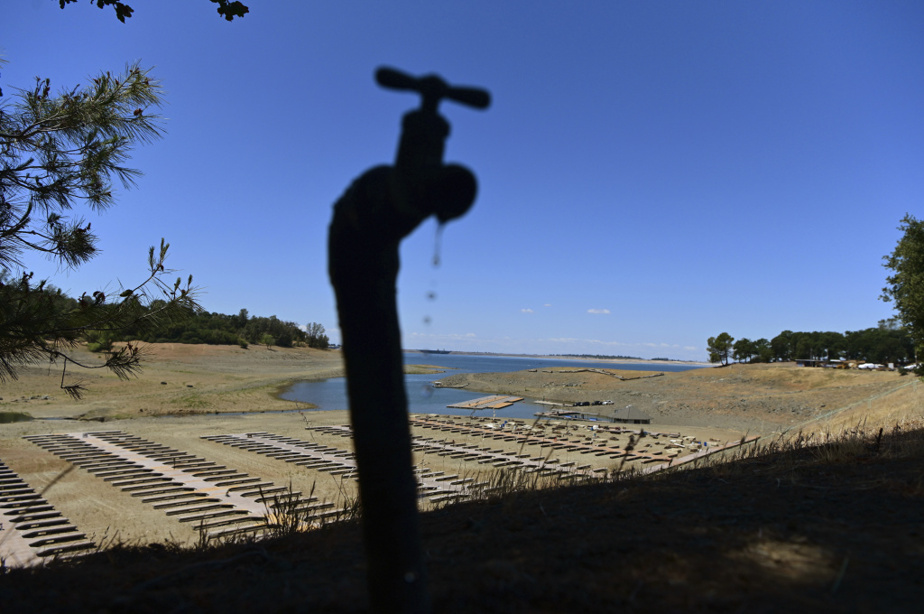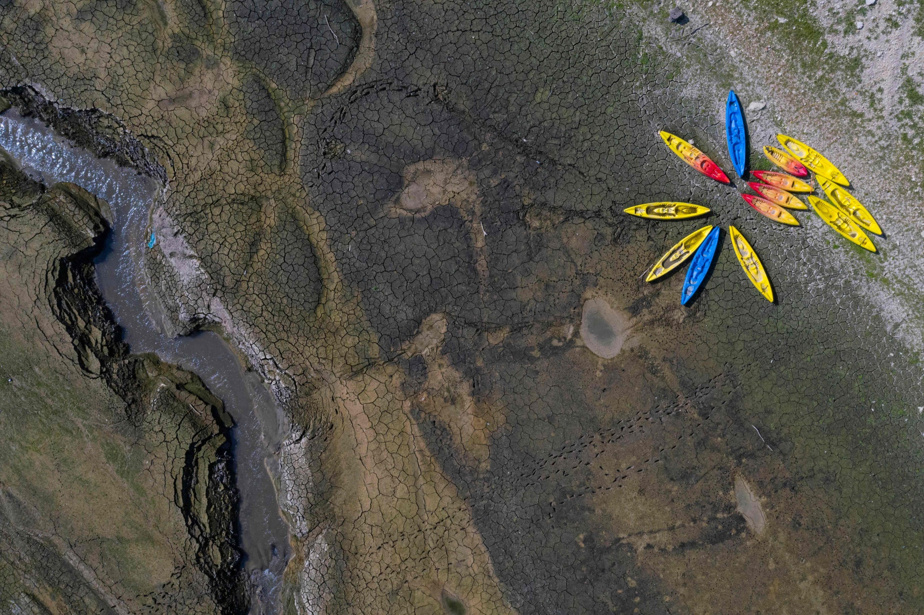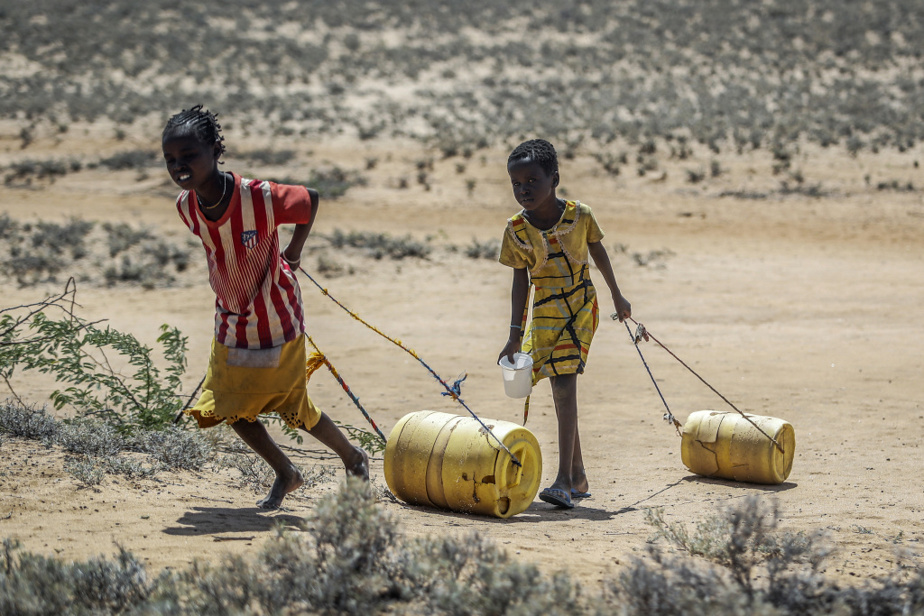
Released at 5:00 p.m.
There is a threat in all four corners of the world
California, USA
Drought now occupies nearly 50% of the United States, according to the National Integrated Drought Information System, which monitors drought data nationwide. As of May 31, the government agency said 90 million people had been affected and 170 million acres of farmland had been affected.

Photo by Josh Edelson, Associated Press
A pipeline is leaking near the dock on Folsom Lake in the drought-stricken state of California.
California’s water supply is becoming increasingly scarce. In fact, 30% of Southern California’s population is at risk of running out of water, while the state water program, the Public Water Supply System, says it will not be able to meet demand in the coming months. In the spring, millions of residents were called upon to reduce their water consumption by 20 to 30%.
France
In France, soil drying intensified when Météo France recorded a 45% rainfall deficit this spring. By 2021, 23 French departments will be subject to water consumption restrictions by the Ministry of Environmental Change. Drought has already hit twice as many fields this year.

Photo by Sebastian Boson, Agencies France-Press Archives
By the summer of 2020, dubs in France were at an all-time low of more than 100 years.
There are four levels of water restrictions in France: alert, alert, high alert and crisis. Eight departments are already subject to crisis controls, which allow citizens to withdraw water only for safety, sanitation, drinking water and sanitation purposes. So water consumption for agriculture is strictly controlled, which disrupts the harvest. The Ministry of Agriculture and Food Sovereignty has increased the allowable expenditure of water agencies by 100 million euros (approximately C $ 135 million) to improve the agricultural sector’s response to climate change.
France is not the only country in Europe affected by the drought. In early June, Portugal recorded its hottest May since 1931. The government also confirmed that 97% of the land area is now in a state of “severe drought”.
India
According to the United Nations, drought in Rajasthan following a severe heat wave of 45.7 degrees Celsius in April has reduced India’s gross domestic product (GDP) by 2-5%. On May 13, the government announced a halt to wheat exports to protect people from food insecurity.

Photo by BRYAN DENTON, The New York Times
The soil in the Indian state of Uttar Pradesh is so dry that it cannot produce enough food for the people.
Since 2010, more than 6,500 people have died from extreme heat, the Agence France-Presse underscores.
According to the World Meteorological Organization, climate change is 30 times more likely to cause extreme heat in India. The UK’s National Weather Service reports that May’s temperatures are the highest in the north of the country since 1966.
Santiago, Chile
Santiago, the capital of Chile, is set to impose a water supply plan this year for the first time in its history due to low rainfall.

Photo by IVAN ALVARADO, REUTERS
The Mapocho River, which flows through Santiago, Chile, is almost dry.
The Mapocho River, which flows through Santiago, has dropped by 57% in the past year, according to official reports. The Chilean Climate and Regression Research Center has recorded a 30% drop in rainfall across the country over the past decade.
The Horn of Africa
Drought continues to threaten food security in East Africa. The Interstate Commission for Development notes that the number of people affected by food insecurity increased by 30% from May to April, from 29 million to 40 million.

Photo by Brian Ingonga, Associated Press
Two women pull barrels filled with water. Northern Kenya is currently suffering from drought.
The Famine Prevention Warning Network notes that there has never been such a small amount of rainfall in the horn of Africa between March and May in the last 70 years.
Morocco
North Africa is also reeling from the drought. Morocco’s Ministry of Agriculture has recorded 35% rainfall since April compared to last year. Grain production is projected to decline by 69% by 2022. Morocco forecast favorable conditions for the harvest of fruits and vegetables, but still expects a 14% decline in agricultural GDP.

Photo FADEL SENNA, Agence France-Presse
Water is scarce in the bed of the Abdel Maumen Dam, about 60 km from Agadir, Morocco.
With Agencies France-Press
“The situation is bad”
Climate change and increasing population are putting pressure on the world’s water supply. Countries are now adapting to this new reality.
Why does drought occur so often?
Short answer: Due to climate change. “It’s important to see climate change as a series of serious events,” said Chris Funk, director of the Center for Climate Change at the University of California, Santa Barbara. Global climate patterns remain the same, but extreme events are more important.
In California, for example, rainfall is increasing in the mountains of Nevada, says Ellen Bruno, a professor in the Department of Agriculture and Resource Management at the University of California. The snowfall, which usually accumulates in the winter, provided the water supply for the summer. Global warming is reducing natural reservoirs and forcing groundwater to recede, he explains.

Photo by Rich Petronselli, Associated Press
Drought-relief watercraft on Lake Oroville, California
What about our water consumption?
Hossain Bonaktari, an assistant professor in the Department of Soil and Food Engineering at Laval University, explains that growing populations are increasing water pressure everywhere in the world. Climate change is forcing society to reconsider its water consumption because the amount of water available during a drought is less than it needs to be.
Back in California, rural areas were the most vulnerable to global warming. Ellen Bruno explains that not all of them are supported by the urban water service and depend on natural reservoirs that dry up every year. The government should provide lorry drinking water to these communities.
Have we reached an irreversible state?
“The situation is serious and we need to be careful,” said Hossain Bonaktari.
In Canada alone, in June 2021, the temperature in British Columbia reached a new record high of 49.6 degrees Celsius. In 2018, the country needed the equivalent of 1.2 million Olympic swimming pools to irrigate agricultural land, with figures showing that water consumption increased by 74% compared to 2012. According to the Canadian Drought Monitoring Instrument (CDT), significant areas of southern Canadian grasslands are already experiencing “severe drought” and “severe drought”.
“Model forecasts for climate change show that this will increase in the future and especially in southern Canadian grasslands,” Hossain Bonaktari confirmed.
In Africa, the situation is worrisome because poverty makes communities more vulnerable to climate change, says Linda Ogallo, a climate change adaptation expert at the Intergovernmental Panel on Development in Djibouti. While some countries are preparing for the worst, some countries are already experiencing its consequences. There should be a common vision to deal with drought, he said.
Is water scarcity likely to create more conflicts?
Yes. In arid areas where water is already scarce, drought increases competition and conflict between these areas, explains Hossain Bonaktari.
And plenty of examples. Conflict is currently raging between Egypt and Ethiopia as the Ethiopian dam reduces the flow of water in the Nile. In the Middle East, the Euphrates, which flows through Syria and Iraq, is being drained by the Ataturk Dam in Turkey. Upper countries benefit from water control, Hossain Bonaktari notes. “You need to consider all the people below to improve the management of the resource.”
How to adapt to this new reality?
Experts say climate model forecasting technology is the most essential way to adapt to drought. Already, some systems are predicting ocean temperatures as early as six to eight months in advance, says Chris Funk. These systems help to operate upstream, meet the needs of communities and better manage the risks associated with drought.
“Take, for example, the amount of energy needed to heat a pot of water. It requires a lot of energy to heat it.
According to Chris Funk, the ability to warn farmers of the coming extreme heat in remote parts of Africa would be a great achievement. Predictive models are developed mainly in Western contexts, whereas the use of data is essential for adverse arid environments, he underlines.
Are the prognosis models adequate?
Although the forecast models are promising, they do not respond to climate emergencies in developing countries, Linda Ogallo notes. Already, communities in Africa are suffering from food shortages and poverty due to drought. He explains that climate forecasting technology is not enough to provide vulnerability to climate change for vulnerable communities. ” [La sécheresse] This is not tomorrow’s problem, it’s today’s problem. ⁇
“We must stop seeing Africans as vulnerable beggars, but as people capable of making a difference in the world.”






